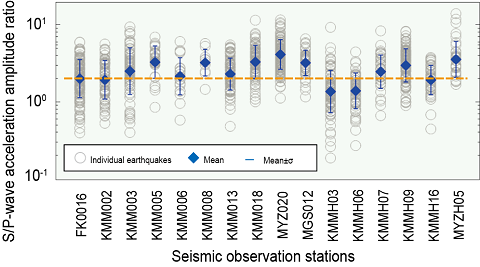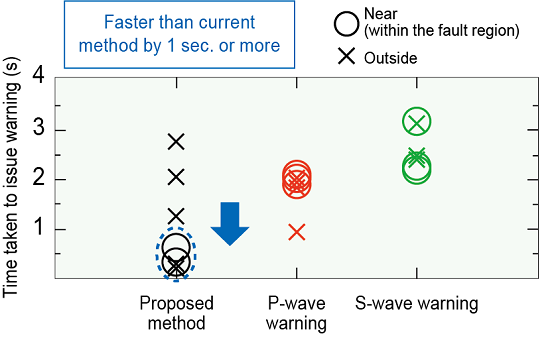1. Earthquake early warning method for the earthquake source fault regions
With current P-wave warnings in railways, it takes at least one second to issue a warning after the earthquake is detected,because data for over one second is needed to estimate the epicentral distance and back azimuth.
To improve the immediacy of alarms for the earthquake source fault regions, we developed a method capable of issuing a warning in less than one second after earthquake detection based on when a specified P-wave threshold is exceeded.
The proposed method determines whether an alarm is necessary based on a real-time prediction of the amplitude of the Swave, which represents the principal motion. This prediction is multiplying the observed P-wave amplitude by the S/P-wave amplitude ratio in advance (Fig. 1).
The S/P-wave amplitude ratio varies widely from station to station, however (Fig. 2).
Thus, the proposed method improves warning accuracy by using the S/P-wave amplitude ratio determined from data at a variety of seismic observation stations. Furthermore, since the method relies only on P-wave amplitude at seismic observation stations and simple arithmetic processing, it enables more immediate and reliable earthquake early warnings in the earthquake source fault regions.
Application of the proposed method to the 2016 Kumamoto earthquake confirmed that the method is capable of issuing a warning faster than any other current P-wave warning system in the earthquake source fault region (Fig. 3).
The adoption of this proposed P-wave “specified threshold exceeded” earthquake warning into warning systems along railway lines can significantly enhance railway safety near the earthquake source fault regions.
Other Contents
- 1. Earthquake early warning method for the earthquake source fault regions
- 2. Design method for bearing parts to control damage and improve restorability
- 3. Method for verifying the restorability of railway structures considering small-and medium-scale earthquakes
- 4. Method for evaluating vehicle safety in strong winds using probabilistic risk assessment
- 5. Inspection of gaps by hammering slab track filling layers and prediction of deterioration
- 6. Method for estimating snow accretion and snow dropping of a train vehicle for investigating countermeasures against snow dropping
- 7. Method of applying image processing-based object detection and obstacle determination to safety applications
- 8. Support system for preventing a decline in alertness level of drivers
- 9. Phased array ultrasonic testing method for easy detection of flaws in bogie frame welds
- 10. Oil for axle-box for Shinkansen with excellent low-temperature performance and maintainability
- 11. Seat surfaces for minimizing injuries to passengers in the event of a collision
- 1. Earthquake early warning method for the earthquake source fault regions
- 2. Design method for bearing parts to control damage and improve restorability
- 3. Method for verifying the restorability of railway structures considering small-and medium-scale earthquakes
- 4. Method for evaluating vehicle safety in strong winds using probabilistic risk assessment
- 5. Inspection of gaps by hammering slab track filling layers and prediction of deterioration
- 6. Method for estimating snow accretion and snow dropping of a train vehicle for investigating countermeasures against snow dropping
- 7. Method of applying image processing-based object detection and obstacle determination to safety applications
- 8. Support system for preventing a decline in alertness level of drivers
- 9. Phased array ultrasonic testing method for easy detection of flaws in bogie frame welds
- 10. Oil for axle-box for Shinkansen with excellent low-temperature performance and maintainability
- 11. Seat surfaces for minimizing injuries to passengers in the event of a collision



